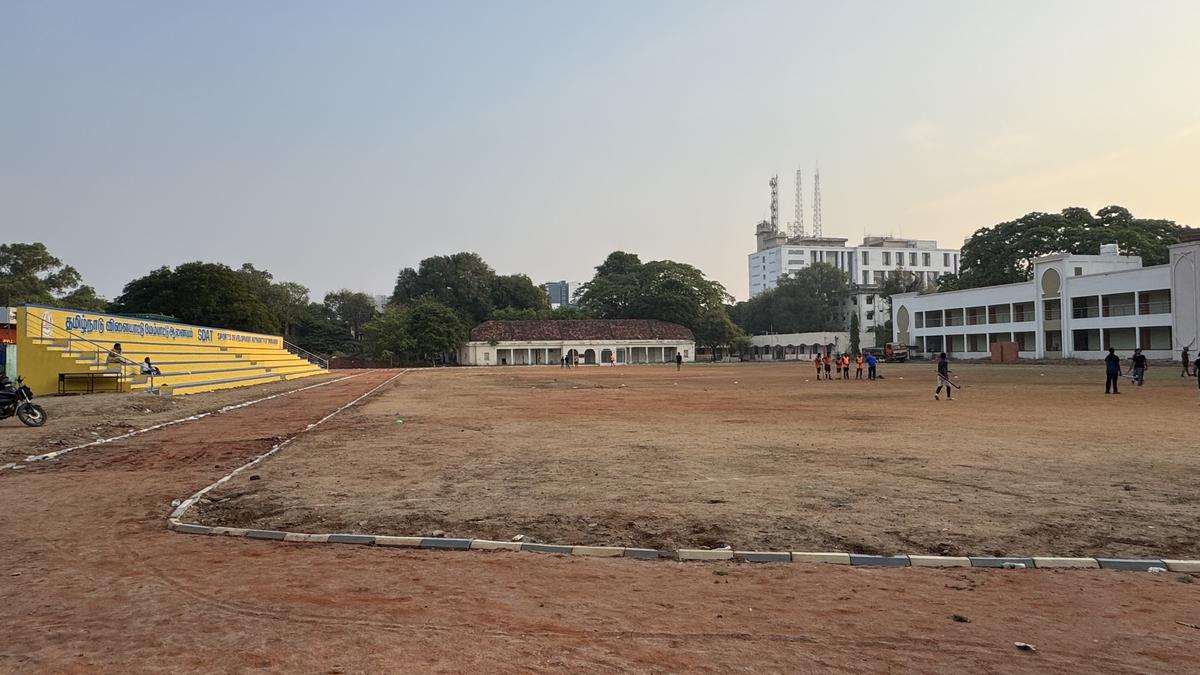
On Anna Salai, a sprawling sports ground and a dilapidated palace
The Hindu
Discover the history and current state of Madras-I-Azam Government Higher Secondary School and Umda Baugh Palace ruins.
Last Saturday, while planning for a heritage walk in the Mount Road/Anna Salai area, I found myself standing at the Madras-I-Azam Government Higher Secondary School, and decided to go in. There were two purposes — one was to mourn over the collapsed Umda Baugh Palace of the Nawabs of Arcot and the other was to look at the vast grounds which have given us several sportsmen and at least one Olympian, namely Munir Sait.
I was pleasantly surprised to find the sports facilities vastly upgraded. The ground now has a mini-stadium, and an early morning hockey game was in progress. Cricket nets have come up too and by their side was a building which I presume contains a gym and changing facilities.
The old school buildings are still in use, but the maintenance of a beautiful, single-storey and tiled set of structures was saddening. The Education Department, or whoever in charge of the place, does not realise what a blessing it is for children to study in such well-ventilated and tree-shaded premises with open courtyards in the middle. The auditorium, which fronts the grounds, is in particular a thing of beauty.
Having come this far, I decided to walk to the Umda Baugh ruin and found it completely inaccessible. Trees and shrubbery have taken over and the new stadium blocks off the place from view. It is imperative that what remains is conserved and taking a leaf out of the Chepauk Palace restoration, the PWD’s heritage conservation cell ought out to do something about Umda Baugh. But my gut feel is that the place is too far gone. Sometimes you need to just accept these losses.
Early in the 19th Century, the premises, then spanning Madrasa-i-Azam and the neighbouring Quaid-e-Milleth Government Arts College, was one massive landholding with the palace at the western end. In 1816, it was owned by Colla Singanna Chetty, a businessman, and after him, the Armenian merchant Edward Samuel Moorat. By the mid-1800s, it was the personal property of Her Highness the Begum Azim Un Nissa, wife of Nawab Ghulam Ghous, the last titular Nawab of Arcot. It was used as a guest-house and this was where the educationist and historian Sir Syed Ahmed Khan and the Seventh Nizam of Hyderabad, Mir Mahbub Ali Khan, stayed when they visited Madras.
The Nizam’s stay here is interesting for Umda Baugh’s frontage was shaped like a scorpion with two curving stairways resembling the pincers. That was exactly how the Nizam’s brother-in-law and Prime Minister, Sir Vicar UlUmra, would design Falaknuma Palace in Hyderabad, which the Nizam himself acquired later and made his principal residence. Today, Falaknuma thrives in splendid fashion, painstakingly restored, while Umda Baugh has collapsed for lack of basic maintenance.
By late 19th Century, the Begum’s descendants had sold Umda Baugh to the Gujarati magnate Lodd Govinddoss. The Nawabs of Arcot had founded the Madrasa-I-Azam in 1849 and the Madras government was running it at Chepauk. In 1901, they approached the Lodd family with a request that the premises be sold to house the Madrasa. The owners graciously agreed to rates far below market value given that the place was going to be used for education.

Tamil Nadu Minister for Rural Development I. Periyasamy told the State Assembly on Tuesday (April 8, 2025) that measures were underway to provide road connectivity to Kadamban Kombai, a tribal hamlet located deep inside the forest, in Nellithurai panchayat, Coimbatore district, at a cost of ₹1.62 crore.





















 Run 3 Space | Play Space Running Game
Run 3 Space | Play Space Running Game Traffic Jam 3D | Online Racing Game
Traffic Jam 3D | Online Racing Game Duck Hunt | Play Old Classic Game
Duck Hunt | Play Old Classic Game










